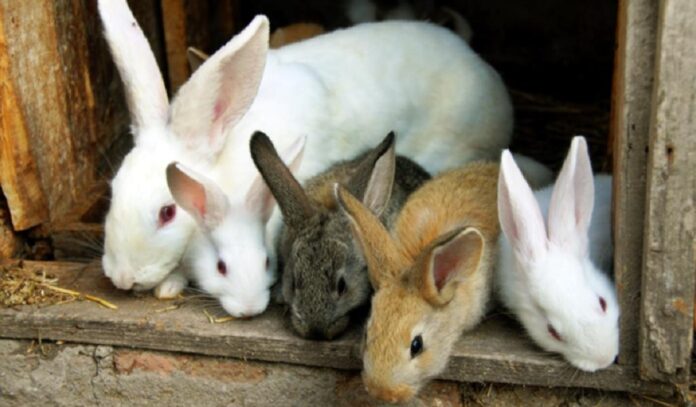Rabbit production is one of the means by which the nutrition and the incomes of most urban and rural dwellers with limited access to agricultural land can be improved. Rabbits are easy to handle, feed and manage. When properly fed they can offer a high protein low-fat meat for healthy eating.
Rabbit production is a possible solution to the perennial meat deficit problem in the country. Anyone can undertake rabbit keeping as a part or full-time venture.
Read also: Rabbit Breeds (With Pictures) For Good Commercial Rabbit Production
Reproduction
Sexual maturity of the doe; 5-6 months; buck 6-7 months
- The preferred age for first mating of the doe; 7-8 months buck 8-9 months
- The mating ration is 1 buck to 7-10 does
- Gestation period 31-33days
Read also: Detailed Guide to Pig production : From the experts
Beginning Rabbit Production
- Obtain the breeding stock from a reputable rabbitry
- Construct a 3 or 2 tier hutch
- Construct feed racks and nest boxes
- Purchase feed/water troughs
Materials for the Hutch, Feed rack and Nest box
- Low grade sawn timber (hardwood)
- Bamboo, raffia palm
- Plastic felt, wire mesh, nails.
Read also: Detailed notes on Cattle Production: From the experts
Floor space for cage construction
| Type | Length | Breath | Height |
| Breeding doe | 90cm | 75cm | 45cm |
| Breeding buck | 75cm | 75cm | 45cm |
| weaners | 74cm | 75cm | 45cm |
Note: keep visitors, domestic pets (e.g. dogs) away from the housing area.
Feeds and Feeding
Rabbits are non-ruminants herbivores and you can feed them on a range of feeds including:
- Grasses: guinea grass, elephant grass
- Succulent herbs: tridax, Euphorbia spp.
- Legumes: centrosema, stylo
- Tree/shrub fodder: leuceanea, pigeon pea.
- Crop residue: maize husk, cowpea/groundnut vines.
- Kitchen leftovers: vegetables trimmings, root and tuber peel
- Cooked food leftovers: rice, yam, cassava
- Concentrates
- Rabbits should receive 100-150g of supplementary feed/day
- Feed rabbits twice daily, morning and late afternoon (evening)
- Provide fresh clean water all the time.
Read also: Important guide to good Cattle Production in Ghana
Management and Sanitation
- Always lift the rabbit with loose skin over shoulder whilst supporting the lower part of the body.
- Young rabbits are held with the hand over loin area with the head pointing downwards.
- Accurate records are important in rabbit management.
- Develop a table for routine management activities such as mating, kindling and weaning to monitor individual performance.
- Develop an individual identification system e.g. Ear tattoo.
- Undertake daily stock inspection to identify sick stock for treatment.
- Undertake daily cleaning of cages and washing water trough.
Read also: 7 Tips on Profitable Farming with Good Records Keeping
Site selection
- Distance to neighbouring residents.
- The direction of prevailing winds in relation to neighbours
- An adequate source of water
- Topography (avoid steep hill)
- Soil type (well-drained soil)
- Proximity to surface water bodies, sinkholes and floodplains
Reference: mofa.gov.gh


